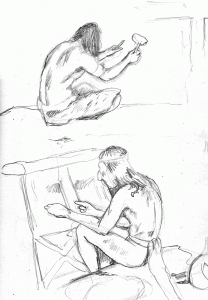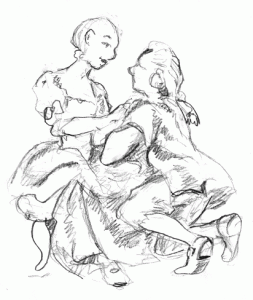 Today’s sketches are details from two paintings by George de Forest Brush which were on tour at the Seattle Art Museum three years ago featuring his idealized visions of Native American Artists. The first is of an Aztec Sculptor. The second is of a weaver.
Today’s sketches are details from two paintings by George de Forest Brush which were on tour at the Seattle Art Museum three years ago featuring his idealized visions of Native American Artists. The first is of an Aztec Sculptor. The second is of a weaver.
A very happy 110th birthday to Mr. Louis Armstrong. And what better way to celebrate it with “What a Wonderful World”. For which version of this is a toss up between the end of the original Hitchhiker’s Guide to the Galaxy and the the montage from Good Morning Vietnam. I find it quite a shame that this wonderful song of hope is mostly used ironically these days.
Because of that I decided to go with the man himself. Enjoy.
http://youtu.be/E2VCwBzGdPM
For today’s Rhapsody we have a Hungarian Rhapsody that has nothing to do with Liszt! (well more accurately wasn’t composed by Liszt. David Popper and Franz Liszt’s lives did entwine.
There’s two versions of this piece one for orchestra and Cello and the other just piano and cello. I decided to go with the piano version as I think I like it better as a duet.
So with out further ado Hungarian Rhapsody by David Popper.
http://youtu.be/l6qkzCrzrUI
 Okay today’s strip is another from the Seattle Asian Art Museum’s Indian sculpture collection. This one is of a Kimnara from either Bhar or Bengal done in the Pala period C 12th century. It’s done in a black stone. I think the main reason I like it is because it kind of reminds me of Despair from Neil Gaiman’s Sandman.
Okay today’s strip is another from the Seattle Asian Art Museum’s Indian sculpture collection. This one is of a Kimnara from either Bhar or Bengal done in the Pala period C 12th century. It’s done in a black stone. I think the main reason I like it is because it kind of reminds me of Despair from Neil Gaiman’s Sandman.
Today’s Rhapsody is Bond’s Gypsy Rhapsody from their album Shine. I’m really fond of these “Classical Crossover” bands that take full advantage of the versatility of the stringed instruments, everything from groups like this to bands like Apocolyptica. If I have any problem with them it’s that I find most of the pieces they play are too short. Musical phrases that haven’t yet tapped into the full potential of what they are doing.
 Today’s sketch is something a little different. I never really had that much of an interest in the Seattle Art Museum’s porcelain collection. But last Saturday I started doing some drawing of the figurines there as a change of scene. This piece is called Oberon and Cynthia from Sevres France done in soft paste biscuit porcelain around 1766-73. The model is by Étienne Maurice Falconet based on a scene from the one act comedy, L’Oracle, by Germain-François Poullain de Saint-Foix.
Today’s sketch is something a little different. I never really had that much of an interest in the Seattle Art Museum’s porcelain collection. But last Saturday I started doing some drawing of the figurines there as a change of scene. This piece is called Oberon and Cynthia from Sevres France done in soft paste biscuit porcelain around 1766-73. The model is by Étienne Maurice Falconet based on a scene from the one act comedy, L’Oracle, by Germain-François Poullain de Saint-Foix.






